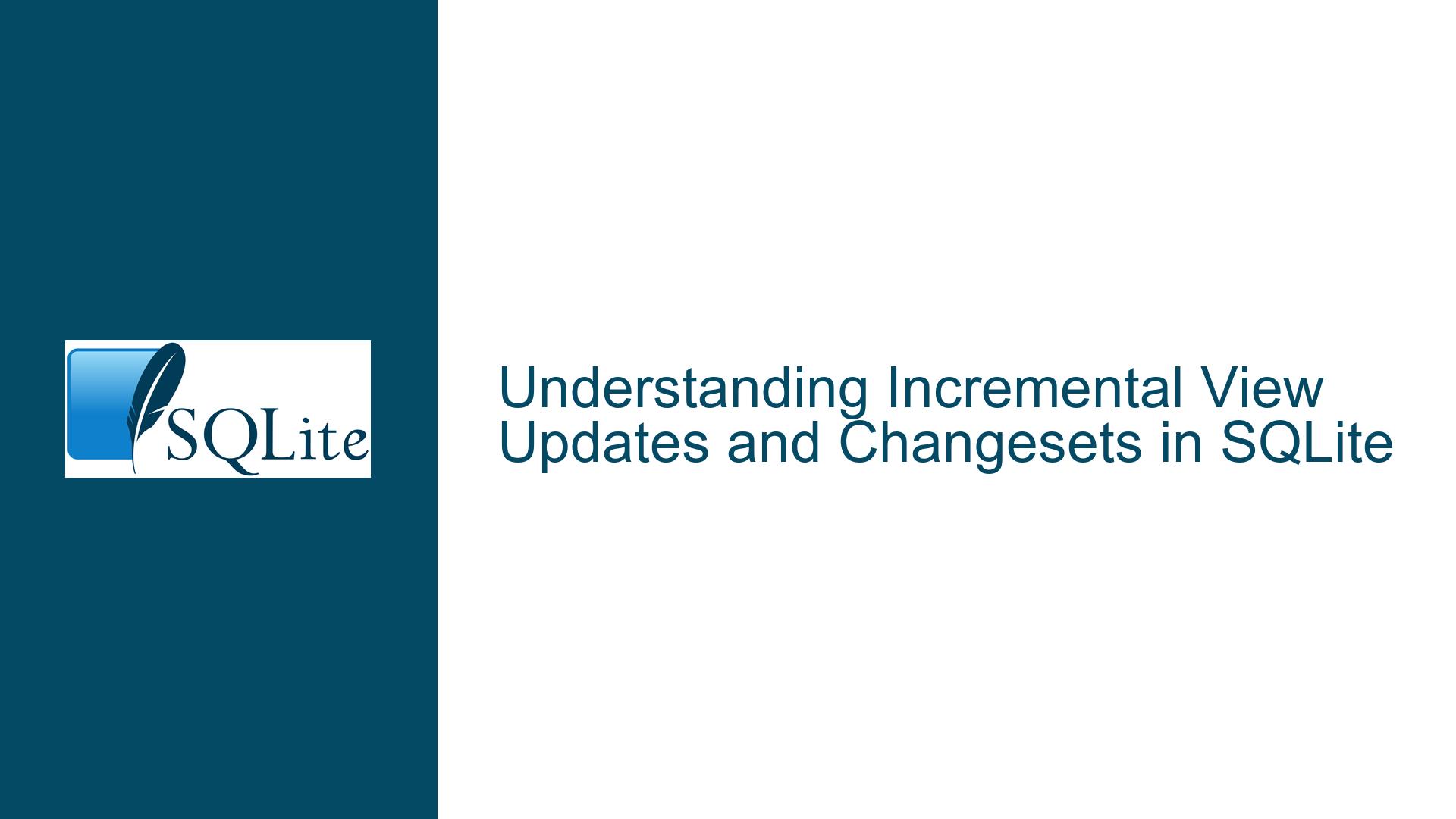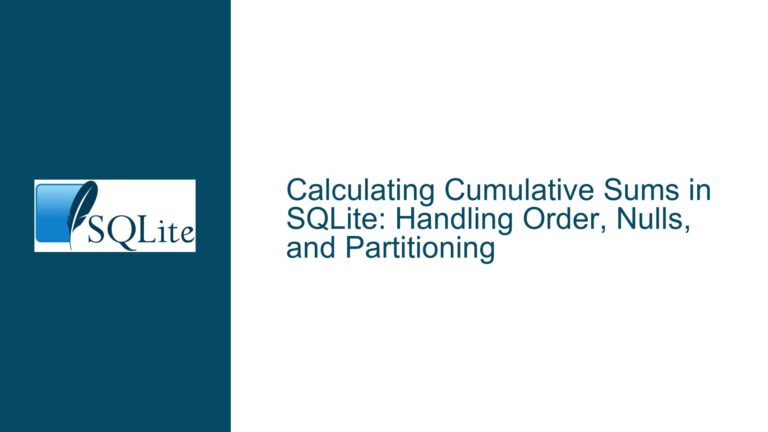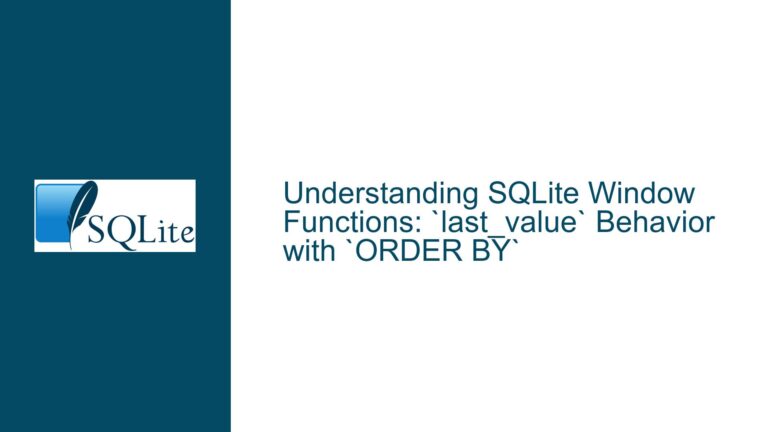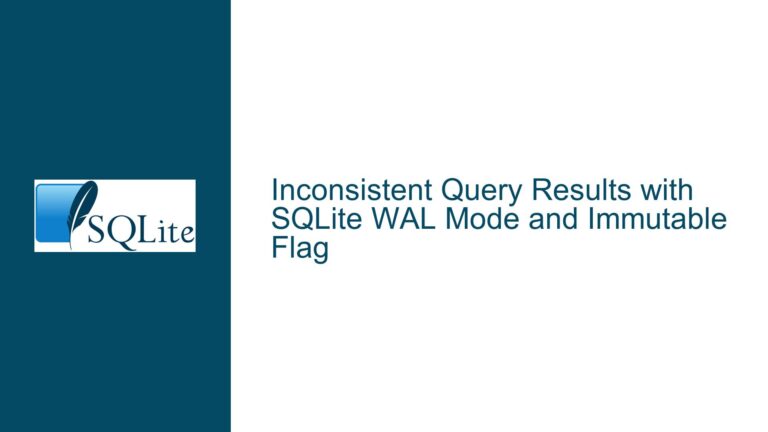Incremental View Updates and Changesets in SQLite
Issue Overview: Incremental View Updates and Changesets in SQLite
The core issue revolves around the ability to generate changesets or incremental updates for SQL queries or views in SQLite. A changeset, in the context of databases, refers to a collection of changes made to the database, typically used for synchronization or replication purposes. The primary challenge here is that SQLite, by design, does not natively support generating changesets for SELECT queries or views because these operations do not modify the database. Instead, they only retrieve data. This limitation raises questions about how to achieve incremental view updates, where the results of a query or view are automatically updated to reflect changes in the underlying tables.
The discussion highlights the need for a mechanism to track how the results of a query or view change over time as the underlying data is modified. This is particularly relevant for applications that require real-time or near-real-time updates to query results without the overhead of recomputing the entire result set. The user inquires whether SQLite’s session extension or any other extension can facilitate this functionality. When it becomes clear that no such extension exists, the conversation shifts to alternative approaches, such as using CREATE TABLE AS SELECT and triggers, to simulate incremental view updates.
The crux of the issue lies in the fact that SQLite does not provide built-in support for materialized views or incremental view maintenance. Materialized views, which store the result of a query and can be refreshed periodically, are a common feature in other database systems like PostgreSQL. However, SQLite’s lightweight and embedded nature means it lacks some of the more advanced features found in larger database systems. This necessitates creative workarounds to achieve similar functionality.
Possible Causes: Why SQLite Lacks Native Support for Incremental View Updates
The absence of native support for incremental view updates in SQLite can be attributed to several factors. First, SQLite is designed to be a lightweight, embedded database engine with minimal overhead. Its primary use cases include mobile applications, IoT devices, and desktop applications where simplicity and low resource consumption are critical. Features like materialized views and incremental view maintenance, while useful, introduce additional complexity and resource requirements that may not align with SQLite’s design goals.
Second, SQLite’s session extension, which is designed to track changes to the database, is limited to recording modifications made by INSERT, UPDATE, and DELETE operations. Since SELECT queries and views do not modify the database, they fall outside the scope of the session extension. This limitation is inherent to the way changesets are defined and implemented in SQLite. Changesets are essentially a record of changes to the database state, and since SELECT queries and views do not alter the state, they cannot be directly tracked.
Third, the concept of incremental view updates requires a mechanism to detect and propagate changes from the underlying tables to the view. This involves maintaining dependencies between the view and the tables it references, as well as computing the differences between the old and new states of the view. Implementing such a mechanism in SQLite would require significant changes to its core architecture, which could compromise its simplicity and performance.
Finally, the lack of demand for this feature in SQLite’s primary use cases may have contributed to its absence. While incremental view updates are valuable in certain scenarios, such as real-time analytics or data synchronization, these use cases are more commonly associated with larger, more feature-rich database systems. As a result, the SQLite development team may have prioritized other features and optimizations that align more closely with the needs of its core user base.
Troubleshooting Steps, Solutions & Fixes: Achieving Incremental View Updates in SQLite
While SQLite does not natively support incremental view updates, there are several approaches to achieve similar functionality using existing features and techniques. These solutions involve a combination of manual intervention, triggers, and temporary tables to simulate the behavior of materialized views and incremental updates.
Using CREATE TABLE AS SELECT and Manual Updates
One approach is to use the CREATE TABLE AS SELECT statement to create a temporary table that stores the result of a query. This table can then be updated manually or through triggers to reflect changes in the underlying data. However, this method requires explicit intervention to refresh the table, which may not be suitable for applications requiring real-time updates.
To implement this solution, you would first create a table to store the query results:
CREATE TABLE query_results AS SELECT * FROM source_table WHERE condition;
Next, you would need to manually update this table whenever the underlying data changes. This can be done using a combination of DELETE, INSERT, and UPDATE statements:
DELETE FROM query_results;
INSERT INTO query_results SELECT * FROM source_table WHERE condition;
While this approach is straightforward, it is not efficient for large datasets or frequent updates. Additionally, it requires careful management to ensure that the query_results table remains consistent with the underlying data.
Using Triggers for Automatic Updates
A more automated approach involves using triggers to update the query_results table whenever changes are made to the source_table. Triggers in SQLite allow you to define actions that are automatically executed in response to specific events, such as INSERT, UPDATE, or DELETE operations.
To implement this solution, you would first create the query_results table as before:
CREATE TABLE query_results AS SELECT * FROM source_table WHERE condition;
Next, you would create triggers on the source_table to update the query_results table whenever changes occur. For example, you could create an INSERT trigger to add new rows to the query_results table:
CREATE TRIGGER update_query_results_insert AFTER INSERT ON source_table
BEGIN
INSERT INTO query_results SELECT * FROM source_table WHERE rowid = NEW.rowid AND condition;
END;
Similarly, you could create UPDATE and DELETE triggers to handle modifications and deletions:
CREATE TRIGGER update_query_results_update AFTER UPDATE ON source_table
BEGIN
UPDATE query_results SET column1 = NEW.column1, column2 = NEW.column2 WHERE rowid = NEW.rowid;
END;
CREATE TRIGGER update_query_results_delete AFTER DELETE ON source_table
BEGIN
DELETE FROM query_results WHERE rowid = OLD.rowid;
END;
This approach ensures that the query_results table is automatically updated whenever changes are made to the source_table. However, it requires careful design and testing to ensure that the triggers handle all possible scenarios and maintain data consistency.
Using the Session Extension for Change Tracking
While the session extension does not directly support tracking changes to query results, it can be used in conjunction with the above techniques to generate changesets for the query_results table. The session extension tracks changes to tables by recording INSERT, UPDATE, and DELETE operations. By applying the session extension to the query_results table, you can generate changesets that reflect updates to the query results.
To use the session extension, you would first attach it to the query_results table:
SELECT sqlite3session_attach(session, 'query_results');
Next, you would enable change tracking for the query_results table:
SELECT sqlite3session_enable(session, 1);
Finally, you would generate a changeset for the query_results table:
SELECT sqlite3session_changeset(session, changeset);
This approach allows you to track changes to the query_results table and generate changesets that can be used for synchronization or replication. However, it does not provide a direct solution for incremental view updates, as the changesets are generated for the query_results table rather than the original query or view.
Exploring External Tools and Libraries
In cases where the above solutions are not sufficient, you may consider using external tools or libraries to achieve incremental view updates. For example, you could use a middleware layer or application logic to monitor changes to the underlying tables and update the query results accordingly. This approach requires additional development effort but offers greater flexibility and control over the update process.
Another option is to use a database system that natively supports materialized views and incremental view maintenance, such as PostgreSQL. While this may not be feasible for all applications, it is worth considering if the requirements for incremental view updates are critical to your use case.
Conclusion
Achieving incremental view updates in SQLite requires a combination of manual intervention, triggers, and temporary tables. While these solutions do not provide the same level of convenience as native support for materialized views, they offer a viable way to simulate incremental updates and generate changesets for query results. By carefully designing and implementing these techniques, you can achieve the desired functionality while working within the constraints of SQLite’s lightweight and embedded nature.






